Explore the best POS systems for restaurants. Compare features, pricing, and use cases to find the right fit for your business.
The best restaurant point-of-sale (POS) systems can be utilized effectively in a variety of restaurant types, providing functionality for your staff while offering great customer experiences for your guests.
I compared dozens of popular restaurant POS systems to find the eight best products on the market. My latest guide covers pricing, features, ease of use, and best use cases for each. Our readers often request user-friendly suggestions, so that took precedence when I weighed the top systems for restaurants.

Toast is consistently one of The Restaurant HQ’s most recommended POS systems. It combines essential tools for order management for online, dine-in, pickup, curbside, and delivery orders with menu and workforce management, and even an email marketing suite. It’s a comprehensive solution at a starter price of $0 up front.
| My score | Starting price per month | Payment processing fees | Contract length | |
 Toast Toast | 4.64/5 | $0 | From 2.49% + 15 cents | 2 years |
| Visit Toast | ||||
 Lavu Lavu | 4.54/5 | $9.99 | Custom | 1 year |
| Visit Lavu | ||||
 Lightspeed Lightspeed | 4.15/5 | $189 | 2.6% + 10 cents | 1 year |
| Visit Lightspeed Restaurant | ||||
 SpotOn SpotOn | 3.98/5 | $0 | From 1.99% + 25 cents | Month-to-month |
| Visit SpotOn | ||||
 Square for Restaurants Square for Restaurants | 3.83/5 | $0 | 2.6% + 10 cents | Month-to-month |
| Visit Square for Restaurants | ||||
 TouchBistro TouchBistro | 3.81/5 | $69 | Custom | 1 year |
| Visit TouchBistro | ||||

Pricing: 2/5
General features: 4.13/5
Niche POS functions: 4.58/5
Ease of use: 5/5
Expert score: 5/5
Toast’s POS system is the best in the restaurant industry. With a whole suite of software tools for restaurant management, you’d be hard-pressed to find a better option. What adds to this is their world-class hardware, meticulously tested to ensure that it can survive in the harsh environments kitchens have to offer.
Their new AI integrations and capabilities make them a leader in the space, using this technology across their vast suite of restaurant tools.
The biggest drawback to Toast is that you’re locked into their contract for two years. Furthermore, when using Toast, you also need to use their payment processing and hardware. This lack of flexibility can be discouraging for restaurant operators seeking a more personalized experience.
That being said, their payment processing rates are fair, and finding better restaurant hardware will be a challenge. With some limited drawbacks, Toast is by far the best restaurant POS system this year.
Monthly software fees
Hardware costs
Processing fees
Pay-as-you-go hardware: Toast is the only provider on this list that offers its proprietary POS hardware at no up-front cost. This can be a game-changer for small restaurants that need to expand their operations.
Flexible hardware: This system supports standard terminals with flip screens, customer-facing displays, tableside/mobile ordering, and restaurant technology like kitchen display systems (KDS) and self-order kiosks. Toast’s self-service kiosk and KDS are among my top recommendations for these restaurant tools.
Toast Go 2 handheld terminal: Toast also supports a fully featured handheld terminal, the Toast Go 2, which enables line busting and facilitates curbside or tableside orders and payments. The Toast Go 2, which is drop-tested and fits in an apron pocket, is a best-in-class product.
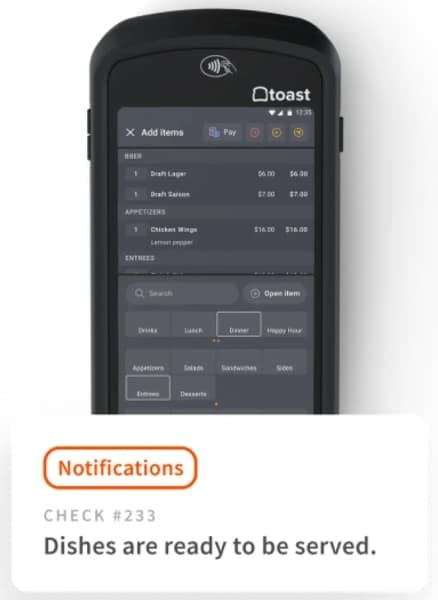
Advanced combo building: Toast’s combo builder operates differently from the others on this list. Rather than relying on nested modifiers, Toast combos operate as a discount type where discounts are applied automatically to possible combos once added to a check.
Drive-thru management: Toast offers a detailed, built-in drive-thru order stream. Configuration instructions can be found on Toast Central, Toast’s online knowledge database.
Once configured, your drive-thru tickets will be color-coded on your KDS screens. You can display an order status for customers on a digital display or send their order status via automated text messages.
Delivery tools: Toast is also one of the best restaurant delivery POS systems on the market. With it, you can manage a team of in-house drivers with GPS mapping integrations or send your in-house orders to local third-party drivers for a flat per-delivery fee.
AI-powered tools: Toast has invested heavily in AI tools and has integrated them into its software in various ways. The Benchmarking tool allows you to see how you’re performing against restaurants in your area, using AI to help you understand where to improve.
The Marketing Assistant helps draw up campaigns quickly using AI. And the new chatbot uses AI for an enhanced intelligent chat feature, helping those who need support more accurately.
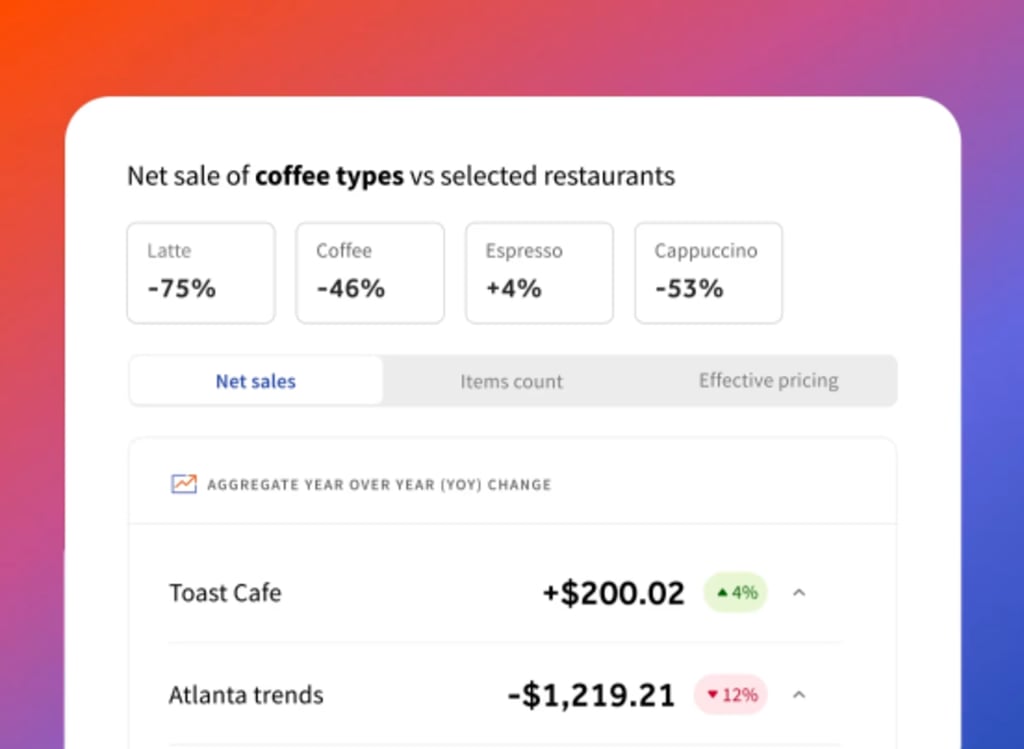

Pricing: 4.44/5
General features: 5/5
Advanced features: 4.3/5
Support: 4.75/5
Expert score: 3.88/5
Lavu comes in second on my POS guide for good reason. While Toast is robust, you may be a restaurant operator with a smaller operation, looking for a less complex system. In my opinion, Lavu is your best bet.
Lavu’s features are cost-effective, with their new $9.99 Freedom Plan offering a wide range of useful features at a more affordable monthly price. They also offer automated cash discounting tools, which are ideal for smaller businesses seeking to maximize every dollar earned.
Several key points hinder the system, one being the lack of transparency regarding their full suite of plans. They also lack transparency in their payment processing fees. Their reporting can be less than robust, and starter kits with their hardware often require a very long commitment.
If you’re a small business owner, using their monthly plan and building from there will yield a reliable POS system.
Monthly software fees
Hardware costs
Processing fees
Cash discount option: Charge different prices for customers who pay with cash vs credit cards. Offset the cost of credit and debit card transaction fees while handily side-stepping laws in 11 states that prohibit passing processing fees onto customers.
Comprehensive baseline POS: Lavu’s baseline POS encompasses all the essential features that you’d expect in a restaurant POS, including basic check splitting, payment splitting, and employee permissions. Ingredient-level inventory is included in the entry-level POS, along with insightful features such as tip pool tracking and built-in employee scheduling tools.
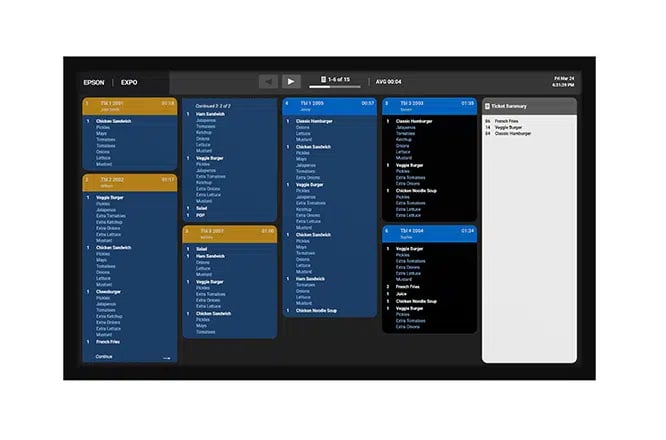
Nutritional information display: Lavu prompts you to add nutritional information to your menu items in the POS. This enables the system to display this information seamlessly to customers on the Lavu self-order kiosk, saving time and customer questions.
You can also add high-resolution menu images to guide your employees and customers through order screens quickly.
Robust integrations: Lavu integrates with over 100 third-party tools, covering everything from accounting to specialized inventory and third-party delivery aggregators. Lavu integrates with Worldpay, BridgePay, Heartland, and Square for seamless payment processing.
Auto-clockout: Lavu has recently introduced an auto-clockout feature that automatically clocks out all employees at a specified location after a set time. For new POS users, this feature can be a valuable way to manage employee labor and ensure that working hours are accurate.
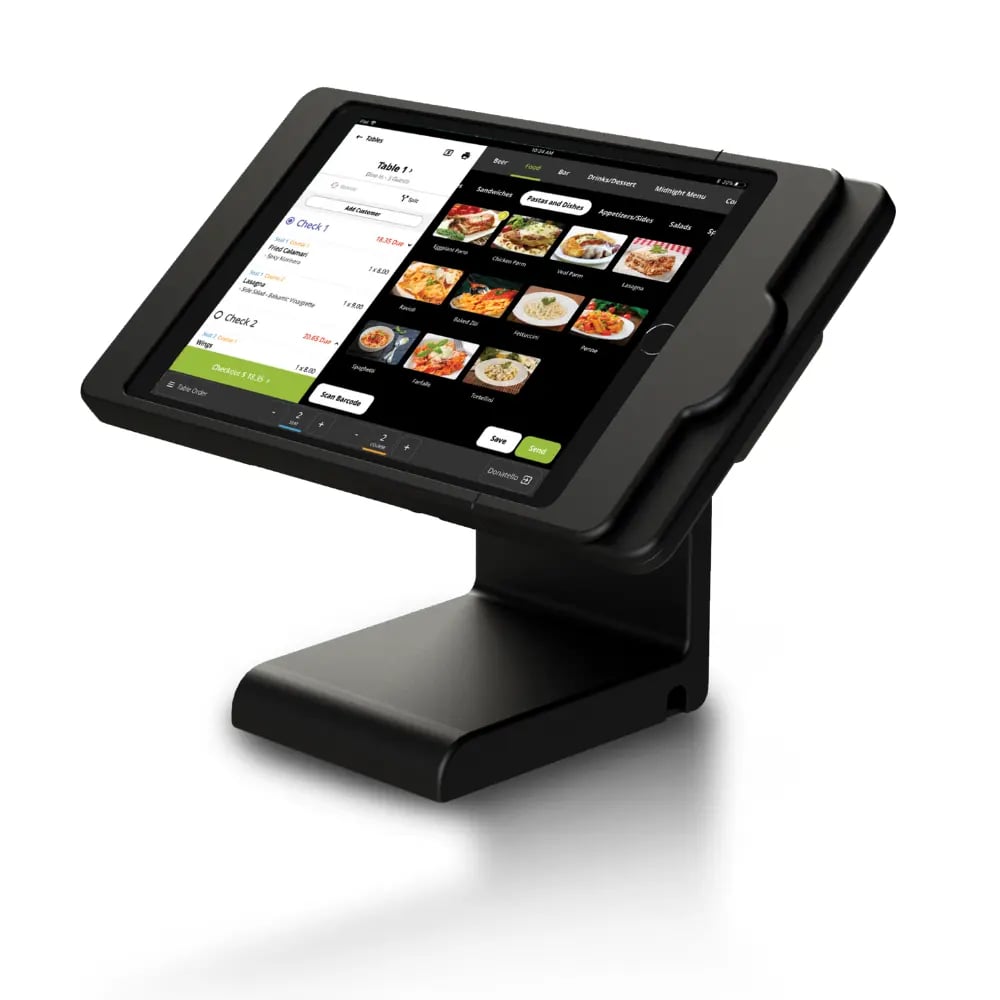

Pricing: 3.63/5
General features: 4.38/5
Advanced features: 4.65/5
Support: 4.56/5
Expert score: 3.6/5
Lightspeed Restaurant has some of the best reporting for restaurants. Deep, robust tools allow you to analyze data effectively. Many operators can’t make data-driven decisions, but Lightspeed enables them to do so, which is a game-changer for businesses with such thin margins.
Their whole suite of tools is incredible, and I could see them moving up our guide next year, with some new Benchmark tools rolled out last year and continuing to be tested this year.
The main drawback to Lightspeed Restaurant is the price. $189 per month is very high, so you may be best served using Lightspeed if you have multiple restaurants or a high-volume restaurant. They do not offer in-house driver management, and their hardware is custom-quoted.
That being said, if data-driven decision-making is important to you as a business owner, then Lightspeed Restaurant is hands down your best bet.
Monthly software fees
Prices are lower for users who pay fees annually and enroll in Lightspeed Payments.
Hardware costs: Custom-quoted
Processing fees: Lightspeed Payments starts at 2.6% + 10 cents for in-person payments.
Advanced reporting: Lightspeed previously required an Essential or Premium subscription to access its excellent reporting tools, but these are now included at every subscription level.
With Lightspeed’s Advanced Insights, your reporting is tied to your Lightspeed Payments data so that you can access a lot of automated analysis on customer purchasing and attendance behavior.
You’ll also get detailed menu reporting with automated recommendations for which dishes need more promotion and which ones should be removed from your menu. Staff productivity and business overview reports are also excellent.
Quick-order mode: Lightspeed Restaurant features a quick-order setting that combines ordering and payment options on a single screen, streamlining orders in a quick-service environment.
Automated vendor management: Lightspeed’s built-in Advanced Inventory tracks your inventory at the ingredient level. A smartphone counting app turns any smartphone camera into a barcode scanner, enabling users to check in deliveries and count inventory quickly.
Reports calculate recipe costs and track price fluctuations from your vendors. The “1-click” reordering function enables you to place orders with multiple vendors with a single click.
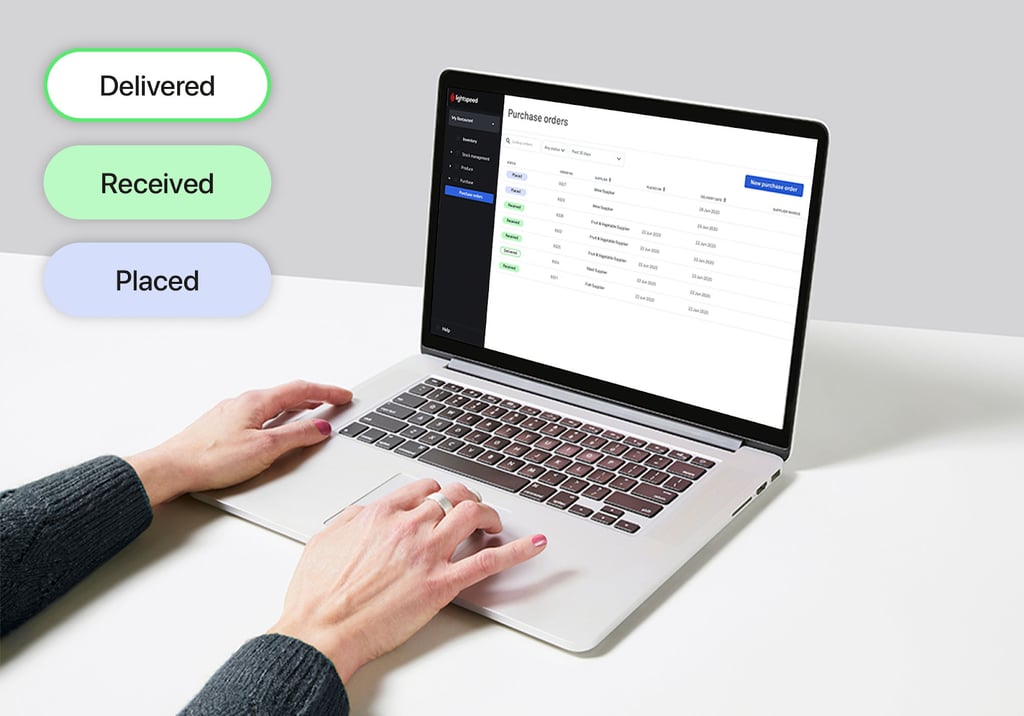
Flexible payments: You can use the fully built-in Lightspeed Payments (which will increase your POS system’s reporting power) or shop for processing rates. Lightspeed also integrates with Cayan, BridgePay, and Worldpay. It may charge a higher monthly fee for using a third-party processor, though, so be sure to contact Lightspeed for a custom quote.
Intuitive search and user designs: Lightspeed now allows you to search your POS system by SKU, helping staff find items quickly. Furthermore, its new order view confirmation banner lets your staff see their actions completed in real-time.
For example, firing a course or adding a discount will be followed by a confirmation alert letting staff know this action has occurred in the system.
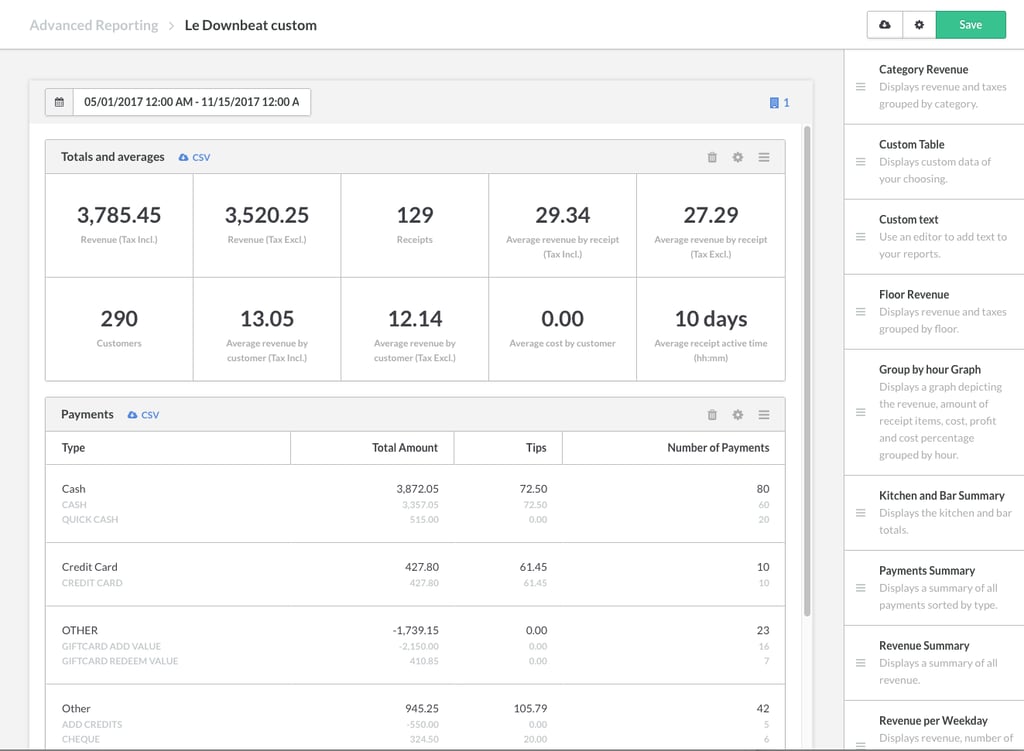

Pricing: 3/5
General features: 4.38/5
Advanced features: 4.53/5
Support: 4.56/5
Expert score: 3.6/5
SpotOn has done a great job of introducing AI into its suite of restaurant POS tools. Their Core Bundle ($50 per month) offers a wide range of excellent restaurant add-ons, many of which utilize AI.
Their Profit Assist helps cut costs by analyzing your P&L, and their Marketing Assist helps create and automate campaigns. They even offer a “Picked for You” option for online retail ordering of products you may sell through AWS. All of these features represent tools meant for businesses with multiple locations or larger volumes.
The drawback for SpotOn is that reports state that setting up the system itself can take a few weeks. You’re also locked into their payment processing rates, which offer no flexibility in determining the amount you pay to process your payments.
Their hardware is quite pricey as well, so having more than one location is ideal to cover costs. Overall, SpotOn is great, and I think it’s at its best when used in restaurant businesses that can spread its features across more than one unit.
Monthly software fees
Hardware costs
Processing fees
SpotOn AI tools: SpotOn has integrated AI into many of its features. A P&L tracker allows the system to analyze your P&L for money-saving opportunities, and its Marketing Assist makes selling to customers easier than ever before.
While at an extra cost, these tools are game changers for operators when it comes to emerging restaurant technology.
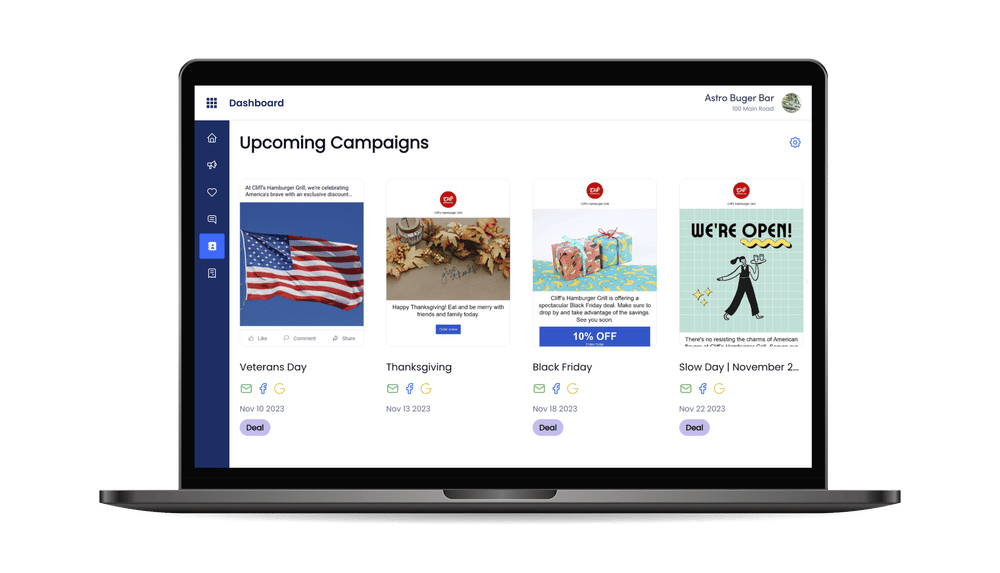
Mobile ordering: Your customers can place group orders and split the bill in multiple ways directly from their smartphones. SpotOn also integrates with Ordr, an app that allows event attendees to order food delivered to their seats in arenas and stadiums.
An integrated order-ready display screen shows takeout customers and delivery drivers exactly when their order is ready.
Contactless payments: SpotOn users can accept NFC and mobile wallet payments on-site and online through SpotOn’s integrated mobile ordering system. Processing rates are lower than those of our competitors (starting at 1.99% + 20 cents for in-person payments), and custom-rate quotes are available. Handheld terminals operate via Wi-Fi and 4G connections, so you’ll never go offline.
Automated upsells and discounts: Your mobile and on-site ordering modules can automatically suggest popular pairing items or apply discounts when an order meets the promotional criteria.
Reservations and bookings: SpotOn’s built-in reservation module is the most complex of the systems on this list. Beyond simple reservations and waitlists, it includes “experience” bookings for special events, such as themed parties, or add-ons like to-go meals.
The system can also accept deposits, allowing you to sell ticket-style events with minimal administrative hassle.
Excellent hardware: SpotOn focuses on offering great hardware. Its handheld terminal, released last year, had an 18% larger screen and included a leather strap for easy handling. Alternatively, its new terminals feature durable HD screens and a slim design, making them easy to fit on a busy expo counter or checkout station.
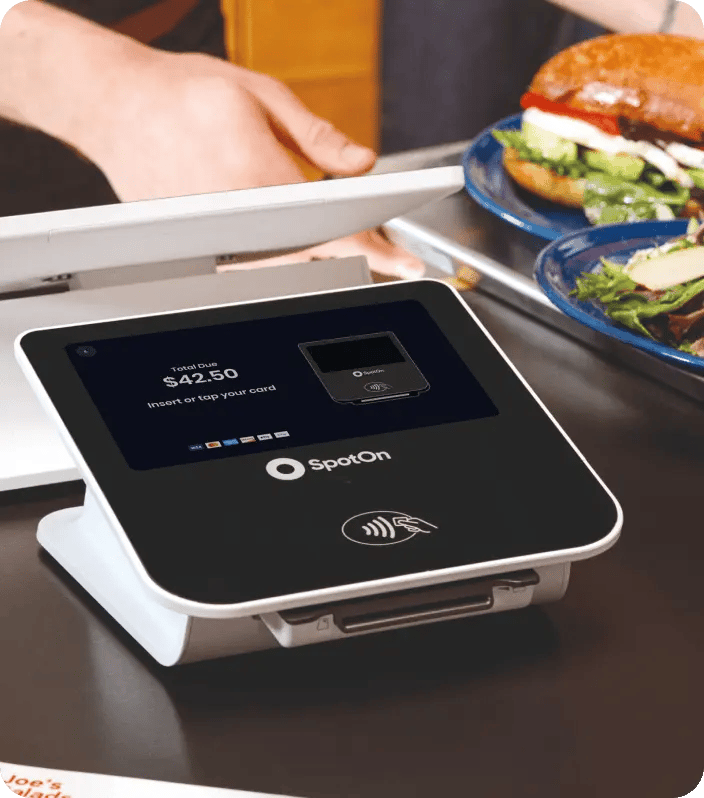

Pricing: 4.31/5
General features: 4.38/5
Advanced features: 2.95/5
Support: 3.75/5
Expert score: 3.08/5
Square is ideal for restaurants that need a free baseline POS, those in growth mode, or small establishments like food trucks, cafes, or bakeries. It’s consistently one of the top POS systems for restaurants available.
Square for Restaurants can utilize generative AI in certain features, which I view as a positive development. Due to Square’s use across various industries, its different AI tools will likely be adapted in unique ways for its restaurant offering, and it’s something to keep an eye on.
In my evaluation, Square lost points due to its limited payment processing options, some basic features, and the need for third-party integration for certain functions. Otherwise, Square for Restaurants is a very approachable POS that can be used to launch a business or in the long term.
Square is worth a shot, especially because of its user-friendly contract terms and free baseline subscription.
Monthly software fees
Hardware costs
Processing fees
Square Gen AI Menu Generator: Square’s new generative AI technology allows users to generate a complete menu within minutes. If you need to build out a menu, make seasonal changes, or just want a refresh, their generative AI tool is your best bet for a quick and efficient solution.
Free baseline POS: Square for Restaurants’ baseline POS is free. It’s best suited for counter service operations that don’t require ringing in orders by course or seat number. However, these restaurants are often overlooked by higher-priced restaurant POS brands, making the free Square for Restaurants POS plan a lifesaver.
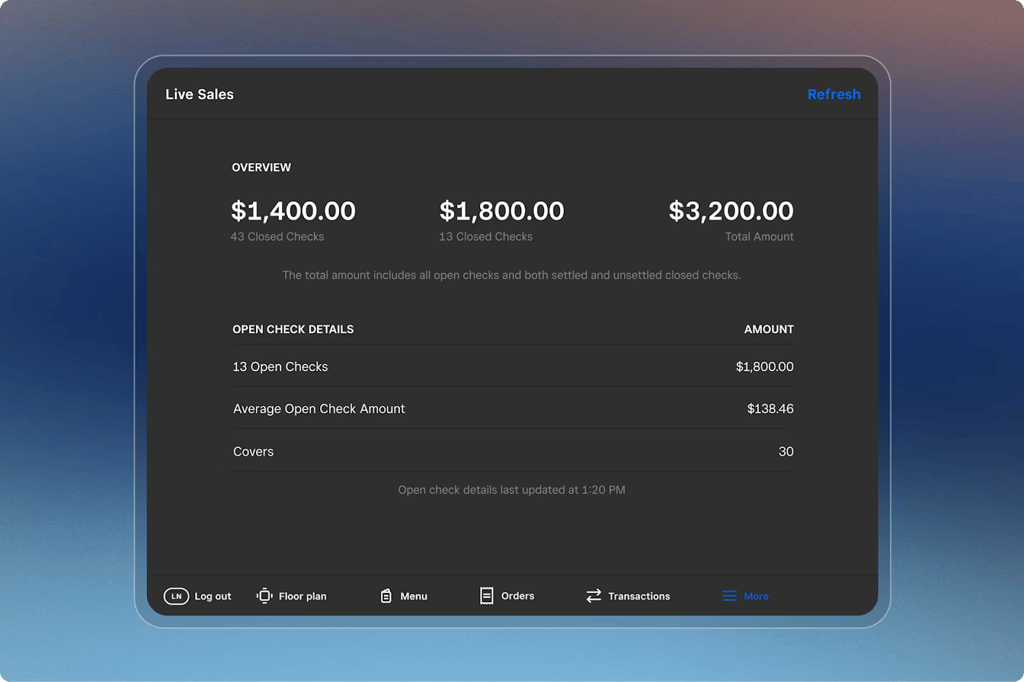
Transparent pricing: Square for Restaurants clearly lists subscription prices, transaction fees, and hardware costs on its website, ensuring transparency. If you have a large-scale restaurant business and believe your costs for using Square for Restaurants will be high, please reach out to the Square sales team for a custom quote for software and payment processing.
No long-term contract: You can start with Square for Restaurants and cancel without penalties if it isn’t a fit for your business.
Flat-rate processing: Initially, Square’s processing fees may seem higher than those of competitors like SpotOn, but Square’s processing fees are truly flat. You pay one fee that only varies by the payment method (in-person, online, card-not-present, etc.).
You won’t pay extra for American Express or rewards cards, and Square won’t ever charge you a chargeback fee if a customer disputes a charge.
Integrated Square ecosystem: You can add integrated online ordering via the free Square Online store and sync your employee time and tip data directly with Square Payroll. Square Invoices has the tools you need if you offer catering or sell food to businesses that pay monthly.
All of these small business tools working together can save you hours of administrative time, especially if you are an owner-manager.
Customized navigation: In March 2024, Square launched an update that allows operators to customize their screen navigation. This update allows you to map buttons and get quick access to key features and reports from the home screen.
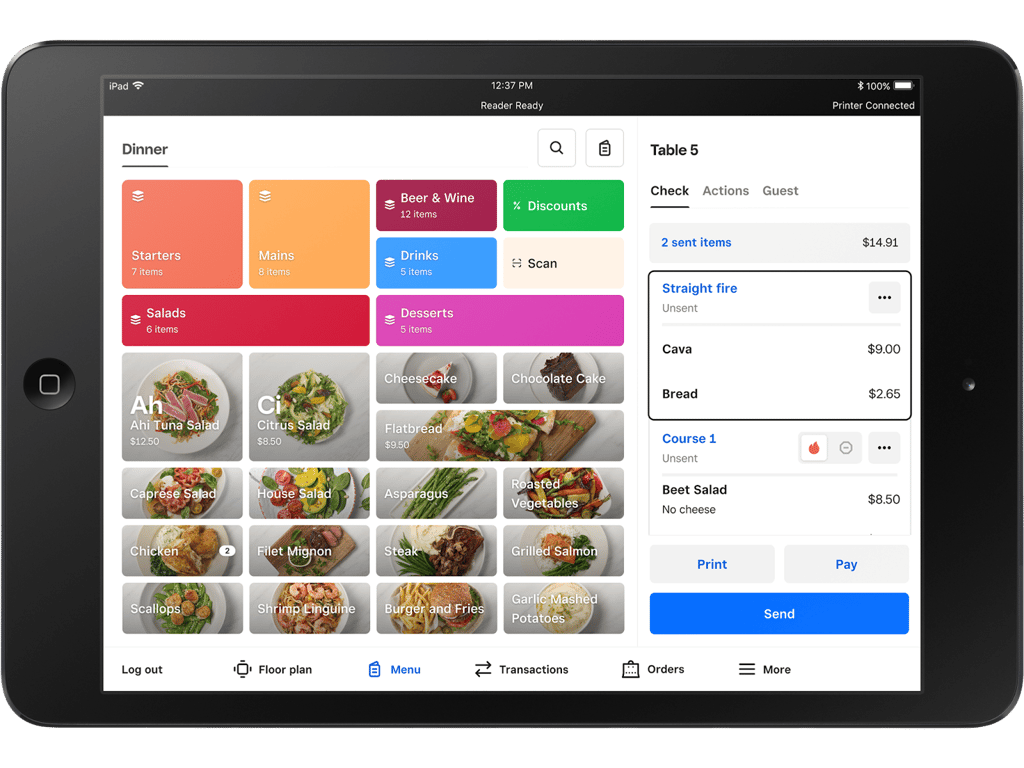

Pricing: 3.38/5
General features: 4.06/5
Advanced features: 3.58/5
Support: 4.25/5
Expert score: 3.74/5
TouchBistro is ideal for new restaurants, as noted in our TouchBistro review, and among those with new staff, high staff turnover, or that require a simple POS system. It has great learning features and is easy to use once you’ve trained your staff.
TouchBistro is an iPad-native system that can be used in various types of restaurants. Easy installation allows you to directly network your iPad POS terminals with one another, creating a seamless, synced environment. The POS operates and relies heavily on the iOS interface, which is a blessing for anyone who has used an Apple product.
Most teams find that new employees quickly adapt to TouchBistro, typically within an hour. This enables you to manage staff functions consistently and provide a great customer experience without exerting effort. It does lack a free trial and payment processor flexibility, and some key add-ons are locked behind fees that can add up.
Monthly software fees:
Processing fees: Custom-quoted
Incredible ease of use: TouchBistro uses the familiar iOS layout to intuitively guide you and your team, including managers, through all the POS features.
Transparent software pricing: TouchBistro lists nearly all of its software pricing publicly. So, while getting a custom quote is a good idea, you won’t have to worry about getting a good deal — you can simply check the TouchBistro website.
Prices range from $25 per month for gift card functions up to $299 per month for built-in reservations.
Streamlined all-in-one POS: You can create custom restaurant floor plans and start tabs with a credit card swipe. TouchBistro tracks your employees’ hours and tips for payroll, supports image-based menus, and includes ingredient-level inventory in the baseline system.
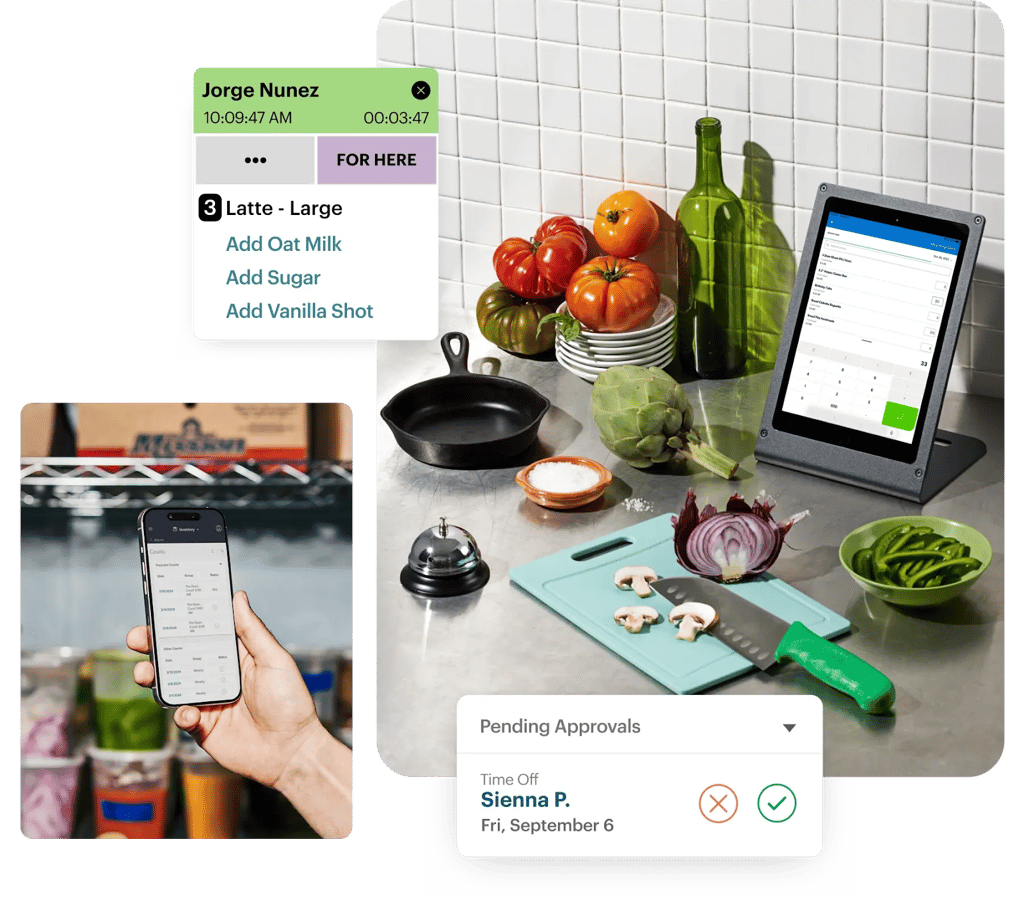
Templatized reporting: If report analysis is not your strong suit, you’ll love TouchBistro’s easy-to-read, visually dynamic reports. Most reports are formatted to include bar graphs and pie charts that show your restaurant’s performance at a glance, so you always know if your numbers tell you to increase your staff levels or drop a costly dish from your menu.
Consistent updates: Native to the iOS ecosystem, TouchBistro experiences many updates. This is actually a good thing, as recent updates have addressed cash inputs into terminals or have focused on smoother integrations with third-party apps.
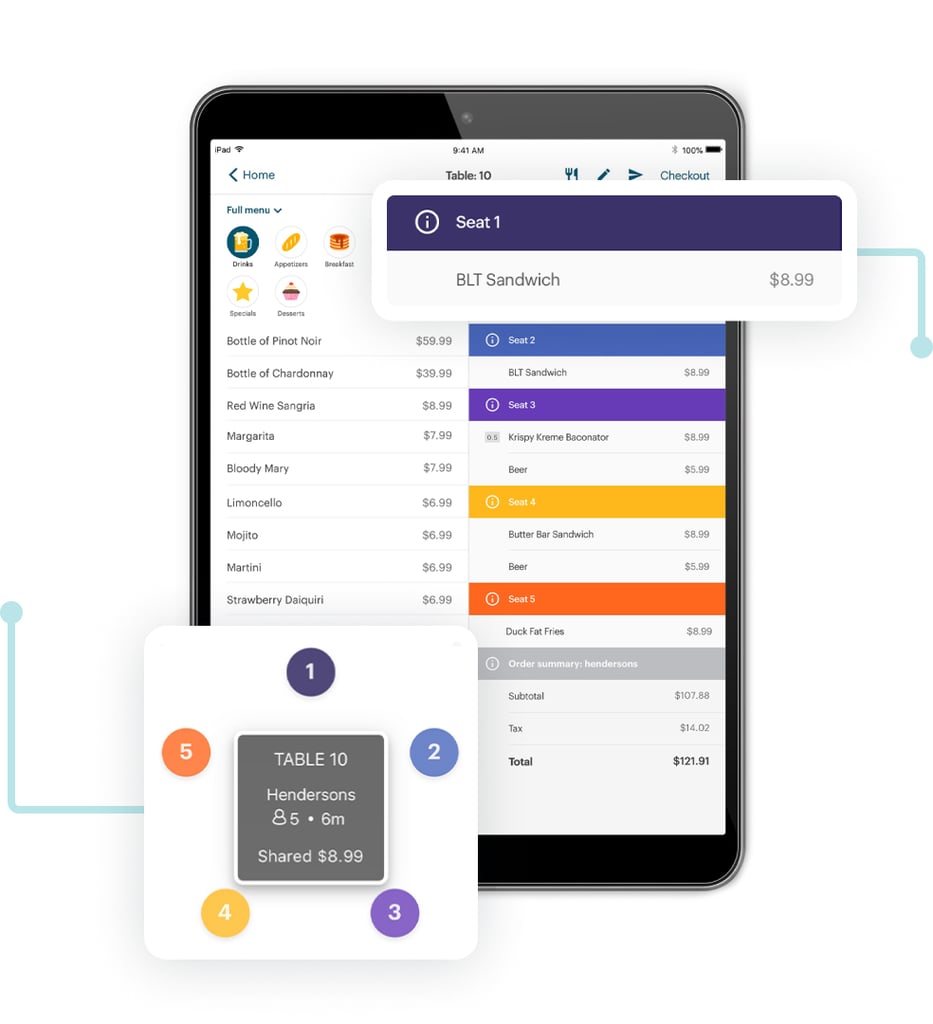
The benefit of having a POS restaurant system is that it continually evolves to meet the changing needs of restaurant operators. Numerous trends and innovations are becoming increasingly commonplace within these systems.
Below are some of the key technology innovations to watch for in the next few years in the restaurant POS system space.
One unique feature many POS systems are integrating is the use of AI to predict sales forecasting. These tools essentially utilize existing sales data to enhance the accuracy of your business’s forecast. This helps restaurants predict their ordering, employee scheduling, and other operational tasks with extremely accurate information, thanks to the AI-powered tools.
POS systems know that customers expect restaurants to offer their services across a variety of sales channels. One of these is online ordering, and the suite of tools for delivering online ordering to customers is constantly expanding.
Furthermore, the ability to sync sales data and execution from different sales channels has been a game-changer for restaurants using advanced POS systems.
Remote access, cloud access, and mobile access to POS systems are increasing, as the software is designed to be functional wherever the operator is using it.
This technology also enables restaurants to eliminate in-house servers, instead relying on flexible cloud servers to store their data. The nature of mobile also allows sales to be executed and paid for on tablets and other mobile devices.
Smart checkout utilizes tools like Apple Pay and Google Wallet to expedite the customer checkout experience. These payments sync with facial recognition or biometric access, allowing customers to make payments through their thumbprint or via quick facial recognition on their cell phone.
Kitchen display screens are also experiencing technological advancement, connecting the kitchen ecosystem like never before. These tools connect to smart printers and other devices, syncing in real time for accurate operation. This helps restaurants better master order tracking, errors, and analytical assessment, allowing them to remove bottlenecks in service and operate more efficiently.
There’s definitely a method to choosing the best POS system for your restaurant. Below is the path I would consider taking when determining the best POS system for your restaurant.
Knowing what you’re actually purchasing a POS system for is the first crucial step in determining which is right for you. For example, having set features that are “must-haves” and knowing the volume of business you expect the proposed POS system to have are both critical when making this decision.
I would determine what the perfect POS system would be for my business and start looking for those key “must-haves” during my POS search.
Restaurants operate on tight margins and precise budgets. Being realistic about what you can afford is crucial when starting your search for a POS system. I would not approach this looking for the cheapest option, but rather the option that fits within your budget while being as robust and useful to your business as possible.
Budget with the intention of not getting a bargain deal, but rather getting a proficient and useful tool that will save you hours of work and elevate your restaurant management ability.
Before committing to any POS system, I highly recommend considering a demo. Most POS software will have demos available, and you should take advantage of them.
The process of getting a demo is usually as simple as reaching out to the POS company’s team and having them walk you through the ins and outs of the service you are potentially subscribing to.
During your search, different POS companies will send you estimates. This can work in your favor, especially for custom-quoted software. Be aware of the costs of the base plan, as well as any necessary add-ons you may need. When you have pricing, you can negotiate with some POS software companies to land on a price that is best for your business.
Once you complete your POS search, select the one that best suits your restaurant. Finalize your decision, and begin onboarding your POS software. Utilize any training or onboarding tools that come your way, as these will be essential for getting started and maximizing the benefits of your POS system.
Download a copy of this restaurant POS checklist as a PDF, Google Doc, or Word Doc to help guide you through your restaurant POS search.
Evaluating a restaurant POS system relies on both the pricing for the system and the general POS features that can be used in a restaurant.
I evaluated these major selling points, paired with any advanced POS systems made for restaurants specifically. I also took into account general support and gave my expert score on each system. Below is a breakdown of each criterion I used for this guide.
Pricing was a crucial factor in this guide, given the range of restaurant types each POS could support. I accounted for free plans, the cost of a monthly subscription, the contract length of a plan, and whether any payment processing flexibility was offered.
Furthermore, I examined the hardware offerings and the maximum number of users each terminal could support.
The general features each restaurant POS should have are order management, inventory management, integrated payments, and kitchen display integrations. I also scored menu item management, reporting analytics, third-party integrations, and workforce management features in this section.
This deeper dive into each POS looked at functions that are specific to restaurants. Kitchen features, loyalty programs, and marketing tools, as well as bar features, were taken into account. Cash management, tipping management, and online ordering and delivery were also taken into consideration.
I considered customer service hours and live customer support options in this section. Additionally, the inclusion of an onboarding or installation manager for a user’s account was considered a valuable addition for users. Finally, online knowledge bases or training resources for each POS will help bring this score up.
My final section was the expert score. This score reflects the overall product offering and the value you get for the money you pay each month. The popularity and general sentiment regarding the ease of use of these systems in the industry were also important for working within this scoring section.
Choosing a restaurant POS system takes time and a lot of consideration. Landing on the right one can literally transform your food business. Below are the most commonly asked questions regarding restaurant POS systems.
Toast offers an excellent product, from an affordable price point to industry-grade hardware, and has thought of pretty much everything you might need out of a restaurant POS system.
While the market is competitive and does have some great options, Toast reigns supreme as the best restaurant POS system.
A restaurant POS system can cost anywhere from $0 to over $200 a month, depending on the software, subscription tier, and your specific needs. Some software companies also offer supplementary features that can help your business, but these can add up. The total price for a POS system can vary from month to month.
There is no one-size-fits-all answer to the best POS system for fast food restaurants, but systems such as Toast and Lightspeed are notable options. All three systems offer excellent multi-location management tools and prioritize POS-to-KDS efficiency for faster order processing and improved customer experiences.
The most common types of POS systems differ in the hardware and networking infrastructure they utilize, but generally include POS apps, cloud-based POS systems, local POS systems, and open-source POS systems, among others.
When it comes to the all-around best POS system for restaurants, Toast is my top choice. Toast caters to the widest variety of food business types and appears to have a solution for every restaurant’s needs.
It’s as if chefs built Toast, as each tool is very well thought-out and complementary to the overall restaurant experience. Their new AI integrations are industry-leading, and it’s an exciting time to be a Toast user.
Thanks to a free starter subscription, pay-as-you-go options, and great hardware, Toast can help restaurants of all sizes succeed and grow within their point-of-sale technology.
Ray Delucci is a graduate of The Culinary Institute of America with a Bachelor’s in Food Business Management. He has experience managing restaurants in New York City, Houston, and Chicago. He is also the host of the Line Cook Thoughts Podcast, where he interviews and shares the stories of foodservice workers. Ray currently works in food manufacturing and food product development.
Property of TechnologyAdvice. © 2025 TechnologyAdvice. All Rights Reserved
Advertiser Disclosure: Some of the products that appear on this site are from companies from which TechnologyAdvice receives compensation. This compensation may impact how and where products appear on this site including, for example, the order in which they appear. TechnologyAdvice does not include all companies or all types of products available in the marketplace.